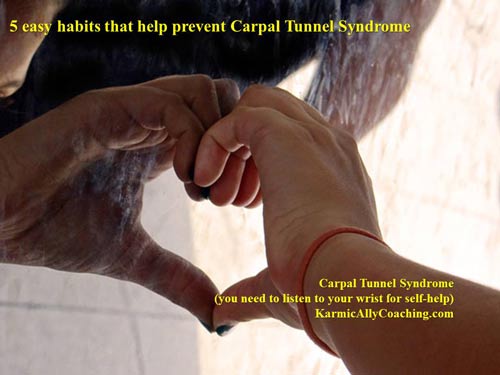This post has already been read 5134 times!

Did you know Carpal tunnel syndrome (CTS) accounts for the greatest median number of days of missed work among the major industrial injuries and occupational diseases?
Or that every year between 3-6% of the American workforce suffer from CTS?
One doesn’t really realize how painful Carpal Tunnel Syndrome can be until experienced. It’s an awful pain, tingling and numbness of the hand and fingers due to nerve impingement in the wrist.
The first time I ever heard of Carpal Tunnel Syndrome was in 1997 when a fellow student studying French at the Alliance Francaise in Tunis told me that she ended up changing her career from a computer data entry desk job to becoming a boutique manager thanks to Carpal Tunnel Syndrome.
Surgery did not work in her case, but she seemed happy with her new life and career. I did not think it important enough to research the subject.
A decade later, the word Carpal Tunnel Syndrome came up again.
This time the IT and Administration Officer at an audit client had to take sick leave thanks to the same condition when his hand went numb. He could not pick up a pen leave alone a coffee mug.
It would still be a few years later when I would wake up in the morning with an indescribable pain in my right-hand middle finger lasting for what seemed to be forever.
The first time this happened; I thought I had slept on the hand and pinched a nerve. When the daily morning episodes started with a burning pain in the wrist as well, a visit to the doctor was in order.
A specialist referral diagnosed it as Carpal Tunnel Syndrome. The technician who did the test told me that the syndrome was starting in the left hand as well and was gleeful that surgery was in order.
I took my prescription from the specialist who suggested I return in a fortnight to discuss possible treatment.
Fortunately, a relative who is a Sports physician advised me to rest the wrist, review my lifestyle to find the cause and take preventive measures. Surgery was supposed to be the last option which luckily was ruled out by some timely action on my part.
What is Carpal Tunnel Syndrome?
According to the National Institute of Neurological Disorders and Stroke:
Carpal tunnel syndrome occurs when the median nerve, which runs from the forearm into the palm of the hand, becomes pressed or squeezed at the wrist.
The median nerve controls sensations to the palm side of the thumb and fingers (although not the little finger), as well as impulses to some small muscles in the hand that allow the fingers and thumb to move.
Although painful sensations may indicate other conditions, carpal tunnel syndrome is the most common and widely known of the entrapment neuropathies in which the body’s peripheral nerves are compressed or traumatized.
Carpal tunnel syndrome is often the result of a combination of factors that increase pressure on the median nerve and tendons in the carpal tunnel, rather than a problem with the nerve itself.
Contributing factors include trauma or injury to the wrist that cause swelling, such as sprain or fracture; over activity of the pituitary gland; hypothyroidism; rheumatoid arthritis; mechanical problems in the wrist joint; work stress; repeated use of vibrating hand tools; fluid retention during pregnancy or menopause; or the development of a cyst or tumor in the canal.
Carpal tunnel syndrome is also associated with pregnancy and diseases such as diabetes, thyroid disease, or rheumatoid arthritis. In some cases, no cause can be identified.
The risk of developing this syndrome is not exclusive to a single industry or a job or to just data entry personnel.
I got lucky that I took timely steps to tackle this problem.
When I posted an update about this problem on Facebook, 3 of my school friends wrote back to say they had experienced the same problem. They had to have surgery for relief. All 3 friends were in different vocations with 1 common factor. They used their hands while working long hours.
In all 3 cases, it came down to using a computer for long hours of the day without taking breaks until the wakeup call rang with excruciating pain. The stress caused by the pain and inability to use the hand with forced rest were also part of the fallout.
If you are experiencing any of the symptoms, do listen to your hand and review your work and lifestyle. I would suggest a visit to the doctor as well to rule out the causes and contributing factors.
Check the additional resources at the bottom of this post to learn more about Carpal Tunnel Syndrome.
5 easy habits that prevent Carpal Tunnel Syndrome

Disclaimer: If you think you might be suffering from this infliction or are showing signs of it, please consult a specialist immediately. The guidance in this post is not a substitute for medical advice.
Prevention is always better than a cure.
Here are 5 easy habits you can adopt to prevent being inflicted with Carpal Tunnel Syndrome if you are using the computer for long hours:
- Check your posture – keep your back straight and ensure that you are not putting too much pressure on your wrists, particularly if you use the computer predominantly during the day.
- Warm up your hands before you begin typing. Try finger push-ups, hand massages and even opening your hands wide and stretching your fingers.
- Take short breaks which can range from a few seconds to a few minutes to relieve pressure on the blood vessels and ensure good circulation.
- Exercise your wrists at regular intervals. Here is a great set of exercises that can be done while standing or even sitting. Extend both arms in front of the body. Then move the backs of the palms and the fingers towards your body. Hold for 10 seconds and then relax the wrists. Then while still holding your arms in front of you keep your wrists straight and curl your fingers into a fist. Squeeze and hold for 10 seconds. The next step is to bend the wrists downwards and hold for 10 seconds. Relax, straighten the wrists and bring your arms back down. You may repeat this exercise about 8 to 10 times.
- Drink lots of water. This helps to flush out the toxins in the body and keeps your muscles supple.
If you already have or suspect that you have this problem, proper medical advice is imperative.
In my case, I learned the hard way to take breaks and rest my hands. Once in a blue moon I wake up with a pain in the middle finger of my right hand and know it is because I lapsed with the breaks and exercises.
I also exercise my hands and fingers with a Smiley Ball.
I acknowledge and accept responsibility for the health of my wrist and hands and do what is needed to avoid going back to the specialist. Prevention is better than a cure. In this case, one’s health is literally in one’s hands.
Have you ever experienced carpal tunnel syndrome? What remedies would you add to my preventive checklist?
Carpal Tunnel Syndrome Management -Useful Resources
Stress Management with Chakra Balancing Exercises by Karmic Ally Coaching
National Institute of Neurological Disorders and Stroke- Carpal Tunnel Syndrome Page
Do you have control over your workspace stress?
Statistics courtesy U.S. Bureau of Labor Statistics and Centers for Disease Control and Prevention (CDC), Morbidity and Mortality Weekly Report (MMWR)
Get yourself one today (click the image below to find it!)
Picture Credit: Listen To The Hand… by Bobbi Jones Jones
This post was written in 2012 and has been updated in 2025 for new information.
Written By: Vatsala Shukla




 I adhere to the Certified Coaches Alliance Code of Ethics and Standards. A copy is available on request.
I adhere to the Certified Coaches Alliance Code of Ethics and Standards. A copy is available on request.
 Let's Talk through the Connect Form:
Let's Talk through the Connect Form:
Thanks for sharing the exercises and what to do , I have known people who have it. Amazing how rest is such a healer- The card I drew today!!!! Thanks for the information xxx
Rest is a wonderful healer, Suzie. Delighted the post and exercises resonated with you!
What great tips! I tried the warm ups and stretching you suggested and it felt great. I’m on the computer a lot, so this information will come in handy.
Delighted to read your experience with the exercises, Julie. They are simple and can be done quickly to yield precious results. Happy typing! 🙂
Great post. My mom had carpal tunnel surgery in both of her hands, successfully, thank goodness. I have been mindful of it ever since. Great advice.
Thanks Summer. It is a painful situation. Sometimes when our loved ones have a health problem, we become careful to make sure we don’t have the same problem. Hope your Mom’s hands are better.
In another life my secretary experienced problems with carpal tunnel syndrome, then years later when I began writing full-time I took measures to avoid the same pain and discomfort by using an ergonomic keyboard and mousepad and taking frequent breaks. It seems to have made a difference since I’ve never had a problem, but I certainly appreciate the additional tips!
A stitch in time definitely saves nine, Marquita. Taking frequent breaks and the ergonomic keyboard and mouse are good preventive measures. Thanks for sharing your additional tips.
Thanks for the information and suggestions! Very helpful! <3
Glad you found the information useful, Jenny.
So many debilitating diseases are the Universe’s way of telling us to slow down and take care of ourselves. Your tips – drinking water, taking breaks, warming up – are all important ways of self-care. (She types, reaching for her cup of water!) xo
I love your reaching out for the cup of water, Reba. 😉 I carry a sipper bottle around the house with me to make sure I have no excuse to not be hydrated. 🙂 Self-care is important, especially if we lead a sedentary lifestyle or have a desk job with lots of manual pounding on the computer keyboard. An annual checkup especially an Executive Checkup is a good start.